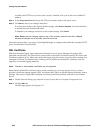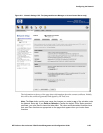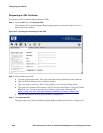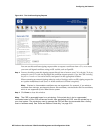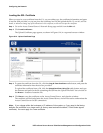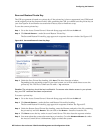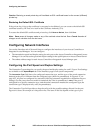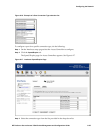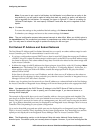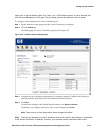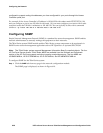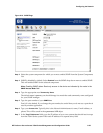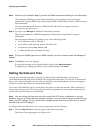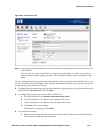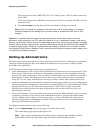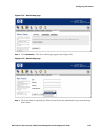Configuring the Network
Note: If you want to set a port to half-duplex, but half-duplex is not offered as an option in the
drop-down list, you will need to select a setting that does not specify an option, and allow the
port to negotiate for half-duplex. For example, as shown in
Figure 6-17, there is no setting for
100baseTX half-duplex. You must specify 100baseTX and allow the port to negotiate for half-
duplex.
Step 4. Click Save.
To restore the settings to the predefined default settings, click
Reset to Defaults
To abandon your changes and revert to the current settings click Cancel.
Note: The port configuration process takes several seconds to take effect. When you initially return to
the
Speed/Duplex tab, the connection type shown in parentheses may reflect the previously configured
type. You may need to refresh the page to update the display for the new type.
Port Subnet IP Address and Subnet Netmask
The Port Subnet IP Address and Port Subnet Netmask lets you specify an subnet address range for each
Access Controller port. The IP subnet address is used in two ways:
• If you have configured an external DHCP server, then for non-NAT clients that request an IP address
via DHCP, the port’s subnet IP address range is used to specify to the DHCP server the IP address range
for clients on this port. This subnet address range does not need to be related to the subnet range used
by the Access Controller.
• It defines the range of valid IP addresses for clients using an Access Policy with a NAT setting of
When
Necessary
(see “The Settings Tab” on page 4-45 in Chapter 4, “Configuring Rights”). In this case, if a
client appears on this port with an IP address outside the range specified for the port, that client’s
address will be NATed.
If the client is allowed to use a real IP address, and the client uses an IP address on the subnet as
defined by the Port Settings for that particular port, then the Access Controller or Integrated Access
Manager will not NAT that client's sessions.
In either case, for packets from the network to a client IP address on a subnet defined in the Port Settings,
the Access Controller or Integrated Access Manager will forward those packets to the appropriate client.
Note: You must specify the DHCP Server IP address in the DHCP Server IP field on the main
Network Configuration page in order to specify port IP subnet ranges. If you have not done so, a
warning will be displayed.
The example in Figure 6-18 shows an Access Controller with two four-port option cards installed. The
port shown as System Board Port 1 is the port labeled Reserved next to the Uplink port on a 700wl Series
chassis. This port is reserved for future use as a management port, but can be used as an extra downlink
port. Up to thirteen downlink ports may be displayed for an Integrated Access Manager 760wl or Access
Controller 720wl, depending on your system configuration.
Up to twelve downlink ports and one uplink port may be displayed for an Integrated Access Manager
760wl or Access Controller 720wl, depending on the system configuration. Four downlink ports and the
uplink port are displayed for an Integrated Access Manager 760wl or Access Controller 720wl.
Note: The Broadcasting section on the Advanced Setup tab under Network Setup displays only
downlink ports. The default uplink port normally does not appear. However, if you have reconfigured the
6-36 HP ProCurve Secure Access 700wl Series Management and Configuration Guide



